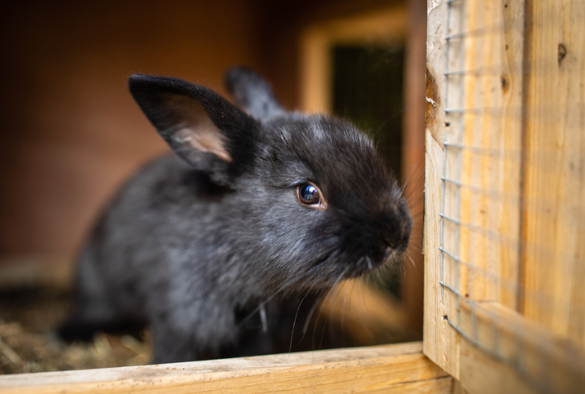
New research has found that 3 in 10 pet rabbits in the UK are being inadequately housed in hutches and cages that are too small for their needs.
An estimated one million rabbits are kept as pets in the UK, making them the third most popular pet behind cats and dogs. However, despite their popularity, research consistently highlights that there is low awareness of their specific welfare needs.
The study by researchers at the University of Liverpool looked at data from the PDSA Animal Wellbeing (PAW) Report* from 2017 to 2019, which sampled 1333 UK rabbit owners.
The researchers found that one-third (31.2%) of rabbits were living in inadequate housing and half were housed alone (51.4%).
While owners of all ages, genders and deprivation levels reported providing inadequate housing, certain demographic groups were identified as being more likely to do so. This included owners that were male, owners aged 25-34 years old, owners with a below-average household income and owners living in deprived areas. However, the researchers caution that their study cannot determine a causal effect and that more research is needed to determine the reasons behind these associations.
The study suggests that whilst more clear and consistent advice about pet rabbit housing needs should be provided to all owners, where resources are limited, campaigns could be most effective if targeted towards the demographic groups they identified.
First author Grace Mee, who completed the research whilst studying for a veterinary degree at the University of Liverpool, said: “Rabbit sales increased by over 200% in 2020, which was more than that of cats or dogs. However, rescue centres are now currently overwhelmed with unwanted pet rabbits. As the third most common pet, I hope that our research will help in providing resources where they will be most helpful to support owners in meeting the welfare needs of their rabbits.”
Co-author Emma Tipton, Evidence and Policy Manager at the PDSA, said: “Findings from our PAW Report continue to show that a worryingly high proportion of rabbits are being housed in unsuitable accommodation. Campaigns that educate owners on rabbits’ five welfare needs are key, as well as elevating the importance of pre-purchase research in potential owners’ minds, ensuring that rabbits have suitable, spacious homes to allow them to hop, run, jump, dig and stretch out fully, and highlighting the importance of having a rabbit companion to live with, will be vital.”
Last year, the first Good Practice Code for Rabbit Welfare in England was published by the All-Party Parliamentary Group for Animal Welfare (APGAW). The public are advised to refer to this before considering rabbit ownership to ensure that they can meet rabbits’ welfare needs. Guidelines include housing rabbits as neutered pairs, with their runs measuring at least 3m long, 2m deep and 1m high.
Project supervisor Dr Carri Westgarth, Senior Lecturer in Human-Animal Interaction at the University of Liverpool, added: “It is essential that there is a shift in rabbit hutch manufacture – rabbits need space and this should be reflected in commercially available housing options for owners. Vets, pet shops, breeders and rescue centres can also help by educating potential owners on the specific requirements of rabbit care.”
This study is published in the journal Veterinary Record.
Rabbit Awareness Week runs from 27th June – 1 July and the theme for this year is ‘Room for Rabbits’ which is all about their environmental welfare needs. For more information please visit https://rabbitawarenessactiongroup.co.uk/
Research reference:
Mee G, Tipton E, Oxley JA, Westgarth C. Owner demographic factors are associated with suitable pet rabbit housing provision in the United Kingdom. Vet Rec. 2022;e1736. https://doi.org/10.1002/vetr.1736
* PDSA Animal Wellbeing (PAW) Report, www.pdsa.org.uk/pawreport